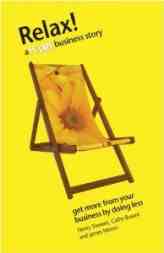Relax! A Happy Business Story
By Henry Stewart, Cathy Busani and James Moran
You can download a free pdf copy of this book on this link:
http://www.happy.co.uk/about/free-publications/
60-Second Main Learning Points
In this fictional tale, a highly stressed small business owner discovers a new way to run his company.
Prologue
What would your organization be like if you completely trusted everybody? What would you have to do to get to that point?
Chapter 1: About Trust and Information
- Without information, people cannot take responsibility – with information, people cannot avoid taking responsibility.
- Agree principles that everyone can work within.
- Train the staff to do the jobs you’re trusting them to do.
- Trust them to do it.
Chapter 2: Celebrate Mistakes
- Celebrate your mistakes and learn from them.
- Imagine what it would be like to work somewhere where you never got blamed for your mistakes… where mistakes were seen as positive things, as outcomes of risk and innovation.
- You can’t learn from your mistakes if you don’t make any mistakes – go make some.
Weekly Mistake meetings – people talk about the mistakes that they made and how they could do things differently. Admit when you, the boss, make a mistake.
Chapter 3: What to Judge Your People On
- Look at how your people’s targets fit within the company principles and targets – get your people to see the big picture.
- Judge your people on the results they achieve, not the number of hours they work.
- Recognize when people have done good work, give your feedback personally and make it specific.
How are they going to know how much you appreciate them unless you tell them? Recognize when anyone does a good job and make sure they all know that you’re pleased with their work. By showing that you appreciate them you’ll increase their motivation and enthusiasm and consequently improve their morale.
Chapter 4: Listening is Different From Hearing
- It’s not enough to hear, you have to really listen to people.
- People say more than they actually “say”.
- If someone is acting out of character, ask them what is really wrong – and how you can help.
- Frame conversations to help people listen better.
Chapter 5: Believe the Best
Always believe the best of your staff. Believing the best should form the basis of every communication.
- Believe the best of people.
- Give them the benefit of the doubt.
- Listen without judgement or assumption.
- Ask how you can help them.
Chapter 6: Hire For Attitude Train for Skill
- Hire people your existing staff will be happy working with.
- Skills can be learnt, a good attitude is either there or not there.
- If somebody is not happy in their current job, see if they can do something else better.
- Set your staff up to succeed – exploit their strengths, not their weaknesses.
Chapter 8: Job Ownership and Full Involvement from Everyone
- Create a framework which gives people ownership over their jobs.
- Get everyone involved in the decisions that affect them.
- If people are involved in decision, they will be more committed to making those decisions work.
Chapter 9: Work/Life Balance
- Help people to balance their home lives with their working lives.
- If people are happier with the balance of their lives, they will be more motivated and produce better work.
Chapter 10: Putting it All Together
- People work best when they feel good about themselves.
- How would your organization be different if management focused on making people feel good?
- Ask your people for ideas – they may know how things work better than you!
Author of this book, Henry Stewart, in these videos, talks about some of the learning from the book:
http://thinkers50.com/sharing/video-library/ ( 5.24)
http://thinkers50.com/sharing/video-library/ (2.28)










Leave a Reply